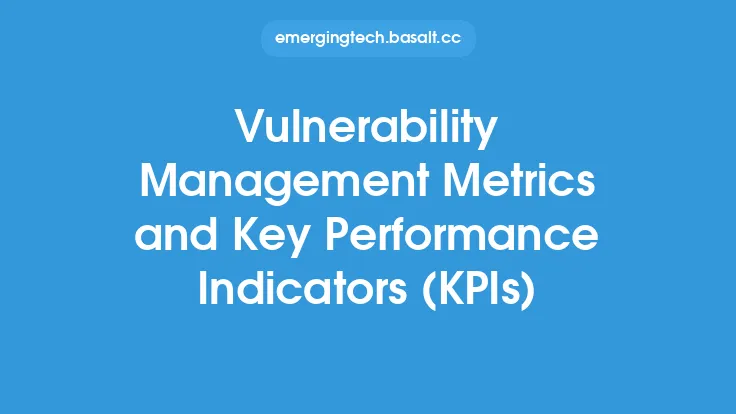Developing a comprehensive vulnerability management strategy is crucial for organizations to protect themselves against cyber threats. A well-planned strategy helps identify, prioritize, and remediate vulnerabilities, reducing the risk of security breaches and attacks. In this article, we will delve into the key components of a vulnerability management strategy and provide guidance on how to develop and implement an effective plan.
Introduction to Vulnerability Management
Vulnerability management is an ongoing process that involves identifying, classifying, prioritizing, and remediating vulnerabilities in an organization's systems, networks, and applications. It requires a proactive approach to stay ahead of emerging threats and vulnerabilities. A vulnerability management strategy should be aligned with the organization's overall cybersecurity posture and risk management framework. The goal is to minimize the attack surface, reduce the risk of security breaches, and ensure compliance with regulatory requirements.
Key Components of a Vulnerability Management Strategy
A comprehensive vulnerability management strategy consists of several key components, including:
- Vulnerability Identification: This involves using various tools and techniques to identify vulnerabilities in systems, networks, and applications. This can be done through vulnerability scanning, penetration testing, and configuration compliance scanning.
- Vulnerability Classification: Once vulnerabilities are identified, they need to be classified based on their severity, impact, and likelihood of exploitation. This helps prioritize remediation efforts.
- Risk Assessment: A risk assessment is essential to determine the potential impact of a vulnerability on the organization. This involves evaluating the likelihood and potential consequences of a vulnerability being exploited.
- Prioritization: Vulnerabilities should be prioritized based on their severity, risk, and potential impact. This ensures that the most critical vulnerabilities are addressed first.
- Remediation: Remediation involves taking corrective action to fix or mitigate vulnerabilities. This can include patching, configuration changes, or implementing compensating controls.
- Monitoring and Review: Continuous monitoring and review are essential to ensure that the vulnerability management strategy is effective and up-to-date.
Developing a Vulnerability Management Strategy
To develop a vulnerability management strategy, organizations should follow these steps:
- Conduct a Risk Assessment: Identify the organization's critical assets, data, and systems, and assess the potential risks and threats.
- Establish a Vulnerability Management Team: Assemble a team with the necessary skills and expertise to develop and implement the vulnerability management strategy.
- Define Vulnerability Management Policies and Procedures: Develop policies and procedures that outline the vulnerability management process, including identification, classification, prioritization, remediation, and monitoring.
- Select Vulnerability Management Tools: Choose tools that can help identify, classify, and prioritize vulnerabilities, such as vulnerability scanners, configuration compliance scanners, and penetration testing tools.
- Implement a Vulnerability Management Process: Develop a process that includes regular vulnerability scanning, risk assessment, prioritization, remediation, and monitoring.
- Train and Educate Personnel: Ensure that personnel understand the vulnerability management process and their roles and responsibilities.
Implementing a Vulnerability Management Strategy
Implementing a vulnerability management strategy requires careful planning and execution. The following steps can help:
- Start with a Baseline Assessment: Conduct a comprehensive vulnerability assessment to identify existing vulnerabilities and establish a baseline.
- Prioritize Remediation Efforts: Focus on remediating the most critical vulnerabilities first, based on their severity, risk, and potential impact.
- Implement a Patch Management Process: Develop a patch management process to ensure that patches are applied promptly and consistently.
- Monitor and Review: Continuously monitor the vulnerability management process and review its effectiveness to identify areas for improvement.
- Continuously Update and Refine: Regularly update and refine the vulnerability management strategy to ensure it remains effective and aligned with the organization's changing risk landscape.
Technical Considerations
From a technical perspective, organizations should consider the following:
- Vulnerability Scanning Tools: Choose vulnerability scanning tools that can scan for vulnerabilities in various systems, networks, and applications.
- Configuration Compliance Scanning: Use configuration compliance scanning tools to ensure that systems and applications are configured securely and in compliance with regulatory requirements.
- Penetration Testing: Conduct regular penetration testing to identify vulnerabilities that may not be detected by vulnerability scanning tools.
- Patch Management: Implement a patch management process that includes automated patch deployment, patch testing, and patch verification.
- Vulnerability Management Metrics: Establish metrics to measure the effectiveness of the vulnerability management strategy, such as the number of vulnerabilities identified, remediated, and remaining.
Conclusion
Developing a comprehensive vulnerability management strategy is essential for organizations to protect themselves against cyber threats. By following the steps outlined in this article, organizations can develop and implement an effective vulnerability management strategy that identifies, prioritizes, and remediates vulnerabilities, reducing the risk of security breaches and attacks. Remember, vulnerability management is an ongoing process that requires continuous monitoring, review, and refinement to ensure it remains effective and aligned with the organization's changing risk landscape.





